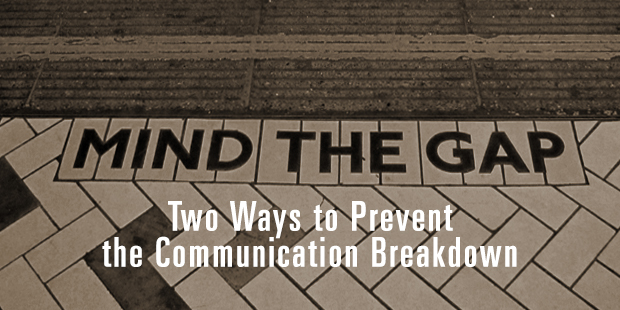
Mind the Gap: 2 Ways to Prevent Communication Breakdowns
Good communication is critical. There have been mountains of books written and countless seminars delivered on the subject. If we know that good communication is so important, then why do we still struggle with it so much? I believe one reason is because we lose sight of the core purpose.
As leaders, the most common purpose of our communication is to change behavior. This might include delivering a rousing sermon on Sunday to encourage discipleship, or coaching a staff member to learn a new skill. So who is responsible if the behavior does not change, or results are not meeting expectations? If we measure the quality of our communication against the resulting behavior, it could change our perspective on the issue.
The meaning of your communication is the response you get.
They Just Don’t Get It
Too often as leaders, we put the burden of understanding on the receiver. It is their job to understand our thoughts, dreams, biases, and personality. If they would just take the time to understand me better, then they would surely grasp the message and do what I asked.
As you might imagine, this line of thinking often takes us down the path of judging others for their inability to get with the program, because they are not smart enough, talented enough, or bought-in enough. If we go further, it might lead us to believe they are even being malicious because they won’t get on board.
When they just don’t get it, there is a gap between your intent and their behavior.
Mind the Gap
I know you think you understand what you thought I said but I’m not sure you realize that what you heard is not what I meant. – Alan Greenspan
In any simple exchange between two people, there is a chain of translation, and the message can get lost anywhere along the way.
- I have an idea in my head, made up of pictures, feelings, words.
- I translate the je ne sais quoi of that mélange into concrete words and pictures to share.
- They hear most of my words and probably lose a few.
- The words they hear have a different meaning and significance for them, potentially triggering an internal response that is very different from what I hoped for.
- They create their behavior to match their internal response (more pictures, feelings, and words) to the perceived message.
With all of those potential gaps in communication, it is a miracle we get anything done! How do we communicate in a way that can close those gaps with all that signal loss?
- Stop Talking and Listen. At each of the above transition points, stop and ask yourself, “how are they receiving my message?” It is important to ask what they received, not just if they’re keeping up. Most of the time, people are not lost in the discussion; they are translating incorrectly. For practical suggestions on how to actively listen to someone, I recommend this blog and video by Greg Salciccioli at CoachWell.
- Get Flexible. Each person is going to respond better to different language structures or examples of the point you are making. As a leader, the burden is on you to be the most flexible communicator in the exchange. If you naturally draw pictures, can you learn to also tell stories or share heartfelt emotions effectively? If you were born in the city, can you learn to share a rural example? The more flexible you are as a thinker and communicator, the more likely you are to elicit the response you are seeking.
Your Next Move
Think of the last time you shared a message and didn’t get the response you anticipated. Identify where the communication broke down and use your flexibility to close that gap.
Would you like to learn how to prevent communication breakdowns? Connect with an Auxano Navigator and start a conversation with our team.












